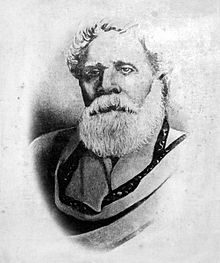Rajnarayan Basu
This article needs additional citations for verification. (August 2022) |
Rajnarayan Basu | |
|---|---|
 Rajnarayan Basu, c. 1899 | |
| Born | 7 September 1826 Boral, 24 Parganas, Bengal Presidency, British India (present-day South 24 Parganas, West Bengal, India)[1] |
| Died | 18 September 1899 Midnapore, Bengal Presidency, British India (present-day West Bengal, India) |
| Nationality | Indian |
| Other names | Rishi Rajnarayan Basu Rajnaryan Bose |
| Education | Hare School |
| Occupation | Writer |
| Spouses |
|
| Children | 1 |
| Relatives | Sri Aurobindo (grandson) |
Rajnarayan Basu (1826–1899) was an Indian writer and intellectual of the
Birth and early life
Basu was born on 7 September 1826, in a
He married Prasannamoyee Mitra in 1843. After the death of his first wife, he married Nistarini Dutta, daughter of Abhayacharan Dutta.[citation needed]
Career
Rajnarayan Basu was a rival of
Work life in Midnapore
He had joined the school on 21 February 1851 preceded by Mr. Sinclare, during whose time the school lost its glory and was in a deplorable condition. Rajnarayan's first goal was to reestablish the school in the firmament of education. The great teacher and educationist took some wonderful steps:
- He had abolished corporal punishment and introduced a friendly and cooperative atmosphere among the teachers and students to make education more interesting to them.
- He had immense hatred against the well-practiced procedure of " committing to memory and vomiting to paper". He always followed the rule of teaching through interaction of both students and teachers. His eloquent speeches with humorous jokes gradually attracted even the heart of the most dull student in the class. He put stress on interrogative teaching, so that the fundamentals of the student becomes strong.
- He understood that the students also need place for physical exercise and sports so that there mental and physical power can be properly manifested, so he made a Lawn Tennis Court and a Gymnasium in the school premises.
- He wanted students to be educated in " Character Making Education", so he advised teachers to look after the moral development of the students, so that they can be " Man in a true sense."
- He observed that students sitting in benches without back-support, cannot keep there back straight, so their attention span becomes shorter while studying. So he introduced sits with back-supports for the first time.
- Being an active leader of Young Bengal, he was moved by the 'Academic Association' of Henry Louis Vivian Derozio. So he also introduced Debate Associations and Mutual Improvement Association in school level.
He also established the first arch of women education in Midnapore, the first girls school and a night school for educating the illiterates. He established a public library that is still in use, although now it is known as the Rishi Rajnarayan Basu Smriti Pathagar (Rishi Rajnaraya Basu Memorial Library) which is the oldest public library in West Bengal. He was the first person to suggest using Bengali at meetings of the
As an intellectual, he founded the Brahmo Samaj house and inaugurated Nabagopal Mitra's Hindu Mela, an organisation created to spread nationalist feelings among Indians.[2] He was a member of the Indian Association and a member of a political group called the Sanjibani Sabha. He also lamented that there were no schools promoting the learning of Indian music among the middle-class[8] and he himself started one in Midnapore. In 1868, he retired and moved to Deoghar where he spent the last years of his life. His grandson, eminent philosopher and freedom-fighter, Sri Aurobindo has inscribed his tribute to Rajnarayan in a beautiful sonnet.
Not in annihilation lost, nor given.
To darkness art thou fled from us and light,
O strong and sentient spirit; no more heaven
of ancient joys, no silence eremite
received thee; but the omnipresent thought
of which thou was a part and earthly hour,
took back its gift. Into that splendour caught
thou hast no lost thy special brightness.Power
remains with thee and old genial force
unseen for blinding light; not darkly larks;
as when a sacred river in its course
dives into ocean, there its strength abides
Not less because with because with vastness wed and works
unnoticed in the grandeur of the tides.
Select bibliography
In Bengali
- Brahmo Sadhon (Serving Brahmoism)(1865)
- Dharmatatvo Dipika (The Light of Religious Theory) (1866–67)
- Hindudhormer srestotto (The superiority of Hinduism)(1873)
- Sekal aar eikaal (Then and now) (1873)
- Hindu othoba Presidency College-er itibritto (A history of the Hindu or Presidency College) (1876)
- Bibidho probondho (Various essays) (1882)
- Rajnarayan Basur Attocharit (Autobiography) (1909)
In English
- A defence of Brahmoism and the Brahmo Samaj (1863)
- Brahmic Advice, Caution, and Help (1869)
- The Adi Brahmo Samaj, its views and principles (1870)
- The Adi Brahmo Samaj as a Church (1873)
References
- ^ a b Rajnarayan Basur Atmacharit, Basu, Rajnarayan, Kuntaline Press, 1909, p. 1
- ^ a b c d Murshid, Ghulam (2012). "Basu, Rajnarayan". In Islam, Sirajul; Jamal, Ahmed A. (eds.). Banglapedia: National Encyclopedia of Bangladesh (Second ed.). Asiatic Society of Bangladesh.
- ^ "রাজনারায়ণ বসু". সববাংলায় (in Bengali). 4 September 2022. Retrieved 14 September 2022.
- ^ Devnath, Samaresh (2012). "Tattvabodhini Patrika". In Islam, Sirajul; Jamal, Ahmed A. (eds.). Banglapedia: National Encyclopedia of Bangladesh (Second ed.). Asiatic Society of Bangladesh.
- ISBN 978-0-691-03125-5.
- ISBN 978-81-260-0428-7.
- ^ Chaudhuri, Indrajit (2012). "Sahitya Parisad Patrika". In Islam, Sirajul; Jamal, Ahmed A. (eds.). Banglapedia: National Encyclopedia of Bangladesh (Second ed.). Asiatic Society of Bangladesh.
- ProQuest 305295764.
